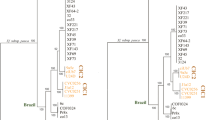Abstract
Reported in Brazil since the 1930’s, citrus leprosis, caused mainly by citrus leprosis virus C, has been a major concern for the national sweet orange production. In recent years, the disease has spread to several other countries and it is now considered a worldwide threat. The occurrence of the disease has been studied almost exclusively in sweet oranges because other citrus genotypes are of secondary relevance in Brazil and in some other American countries where it occurs. Here we report 12 resistant citrus genotypes among 160 accessions evaluated. After 90 days of the infestation with viruliferous mites, asymptomatic genotypes were observed in sour orange, lemon, grapefruit, mandarins, tangelo, and tangor groups. The results revealed promising genotypes resistant to the disease, which can be incorporated in citrus breeding programs aiming to obtain varietal resistance, and confirmed the susceptibility of many citrus genotypes to CiLV-C. This assay ratify the already reported uneven level of susceptibility within the citrus group.

Similar content being viewed by others
References
Afonso CL, Amarasinghe GK, Bányai K, Bào Y, Basler C, Bavari S, Bejerman N, Blasdell KR, Briand F-X, Briese T, Bukreyev A, Calisher CH, Chandran K, Chéng J, Clawson AN, Collins PL, Dietzgen RG, Dolnik O, Domier LL, Dürrwald R, Dye JM, Easton AJ, Ebihara H, Farkas SL, Freitas-Astúa J, Formenty P, Fouchier RAM, Fù Y, Ghedin E, Goodin MM, Hewson R, Horie M, Hyndman TH, Jiāng D, Kitajima EW, Kobinger GP, Kondo H, Kurath G, Lamb RA, Lenardon S, Leroy EM, Li C-X, Lin X-D, Liú L, Longdon B, Marton S, Maisner A, Mühlberger E, Netesov SV, Nowotny N, Patterson JL, Payne SL, Paweska JT, Randall RE, Rima BK, Rota P, Rubbenstroth D, Schwemmle M, Shi M, Smither SJ, Stenglein MD, Stone DM, Takada A, Terregino C, Tesh RB, Tian J-H, Tomonaga K, Tordo N, Towner JS, Vasilakis N, Verbeek M, Volchkov VE, Wahl-Jensen V, Walsh JA, Walker PJ, Wang D, Wang L-F, Wetzel T, Whitfield AE, Xiè JT, Yuen K-Y, Zhang Y-Z, Kuhn JH. Taxonomy of the order Mononegavirales: update 2016. Arch Virol. 2016;161:2351–60.
Bastianel M, Oliveira AC, Cristofani M, Guerreiro Filho O, Freitas-Astúa J, Rodrigues V, Machado MA. Inheritance and heritability of resistance to citrus leprosis. Phytopathology. 2006;96:1092–6.
Bastianel M, Nicolini F, Segatti N, Novelli VM, Rodrigues V. Response of mandarin cultivars and hybrids to citrus leprosis virus. J Plant Phytopathol. 2008;90:307–12.
Bastianel M, Novelli VM, Kitajima EW, Kubo KS, Bassanezi RB, Machado MA, Freitas-Astua J. Citrus leprosis: centennial of an unusual mite-virus pathosystem. Plant Dis. 2010;94:284–92.
Beard JJ, Ochoa R, Brawell WE, Bauchan GR. Brevipalpus phoenicis (Geijskes) species complex (Acari: Tenuipalpidae)—a closer look. Zootaxa. 2015;3944:001–67.
Bitancourt AA. Studies on the “leprosis” disease of citrus. Arq Inst Biol. 1955;22:161–231.
Boaretto MAC. Transmissibility of leprosis by Brevipalpus phoenicis (Geijskes, 1939) (Acari: Tenuipalpidae) fed temporarily in intermediar hosts under laboratory conditions. Científica. 1994;22:81–93.
Childers CC, Rodrigues JCV, Welbourn WC. Host plants of Brevipalpus californicus, B. obovatus and B. phoenicis (Acari: Tenuipalpidae) and their potential involvement in the spread of virus diseases vectored by these mites. Exp Appl Acarol. 2003;30(1–3):29–105.
Cruz-Jaramillo JL, Ruiz-Medrano R, Rojas-Morales L, López-Buenfil JA, Morales-Galván O, Chavarín-Palacio C, Ramírez-Pool J, Xoconostle-Cázares B. Characterization of a proposed dichorhavirus associated with the citrus leprosis disease and analysis of the host response. Viruses. 2014;6:2602–22.
Dietzgen RG, Kuhn JH, Clawson AN, Freitas-Astúa J, Goodin MM, Kitajima EW, Kondo H, Wetzel T, Whitfield AE. Dichorhavirus—a proposed new genus for Brevipalpus mite-transmitted, nuclear, bacilliform, bipartite, negative-strand RNA plant viruses. Arch. Virol. 2014;159(3):607–19.
Dominguez FS, Bernal A, Childers CC, Kitajima EW. First report of citrus leprosis on Panama. Plant Dis. 2001;85:228–228.
Freitas-Astúa J, Fadel AL, Bastianel M, Novelli VM, Antonioli-Luizon R, Machado MA. Differential response of citrus species and hybrids to leprosis. Pesq. Agropec. Bras. 2008;43:809–14.
Kitajima EW, Mulle RGW, Costa AS, Yuki W. Short, rod-like particles associated with Citrus leprosis. Virology. 1972;50:254–8.
Kitajima EW, Chagas CM, Rodrigues JCV. Brevipalpus-transmitted plant virus and virus-like diseases: cytopathology and some recent cases. Exp Appl Acarol. 2003;30:135–60.
Kubo KS, Novelli VM, Bastianel M, Locali-Fabris EC, Antonioli-Luizon R, Machado MA, Freitas-Astúa J. Detection of Brevipalpus-transmitted viruses in their mite vectors by RT-PCR. Exp Appl Acarol. 2011;54:33–9.
Locali EC, Freitas-Astúa J, Souza AA, Takita MA, Astúa-Monge G, Antonioli-Luizon R, Kitajima EW, Machado MA. Development of a molecular tool for the diagnosis of leprosis, a major threat to the citrus production in the Americas. Plant Dis. 2003;87:1317–21.
Melzer MJ, Sether DM, Borth WB, Hu JS. Characterization of a virus infecting Citrus volkameriana with citrus leprosis-like symptoms. Phytopathology. 2012;102:122–7.
Nunes MA, De Oliveira CAL, De Oliveira ML, Kitajima EW, Hilf ME, Gottwald TR, Freitas-Astúa J. Transmission of Citrus leprosis virus C, by B. phoenicis (Geijskes) to alternate host plants found in citrus orchards. Plant Dis. 2012;96:968–72.
Rodrigues JCV. Relações patógeno-vetor-planta no sistema leprose dos citros. PhD Thesis, Centro de Energia Nuclear para a Agricultura, Universidade de São Paulo, Piracicaba, SP, BR; 2000. 168 p.
Ramos-González PL, Chabi-Jesus C, Guerra-Peraza O, Breton MC, Arena GD, Nunes MA, Kitajima EW, Machado MA, Freitas-Astúa J. Phylogenetic and molecular variability studies reveal a new genetic clade of Citrus leprosis virus C. Viruses. 2016;8:153. https://doi.org/10.3390/v8060153.
Ramos-González PL, Chabi-Jesus C, Guerra-Peraza O, Tassi AD, Kitajima EW, Harakava R, Salaroli RB, Freitas-Astúa J. Citrus leprosis virus N: a new dichorhavirus causing citrus leprosis disease. Phytopathology. 2017;107(8):963–76.
Rodrigues JCV, Childers CC. Brevipalpus mites (Acari: Tenuipalpidae): vectors of invasive, non-systemic cytoplasmic and nuclear viruses in plants. Exp Appl Acarol. 2013;59:165–75.
Rodrigues JCV, Kitajima EW, Childers CC, Chagas CM. Citrus leprosis virus vectored by Brevipalpus phoenicis (Acari: Tenuipalpidae) on citrus in Brazil. Exp Appl Acarol. 2003;30:161–79.
Rodrigues V, Bastianel M, Kubo KS, Fadel AL, Nicolini F, Novelli VM, Freitas-Astúa J. Improved method for experimental transmission of citrus leprosis. Laranja. 2007;28:29–38.
Roy A, Shao J, Hartung JS, Scheneider W, Brlansky RH. A case study on discovery of novel Citrus leprosis virus Cytoplasmic Type 2 utilizing small RNA libraries by next generation sequencing and bioinformatic analyses. J. Data Min. Genom Proteom. 2013;4:2–7.
Roy A, Stone A, Otero-Colina G, Wei G, Choudhary N, Achor D, Levy L. Genome assembly of Citrus leprosis virus nuclear type reveals a close association with Orchid fleck virus. Genome Announc. 2013;1:4–5.
Roy A, León MG, Stone AL, Schenider WL. First report of Citrus leprosis virus nuclear type in sweet orange in Colombia. Plant Dis. 2014;98:1162.
Roy A, Stone A, Shao J, Otero-Colina G, Wei G, Achor D, Choudhary N, Levy L, Nakhla MK, Hartung JS, Scheneider W, Brlansky RH. Identification and molecular characterization of nuclear Citrus leprosis virus, a member of the proposed Dichorhavirus genus infecting multiple citrus species in Mexico. Phytopathology. 2015;105:564–75.
Sánchez-Velázquez EJ, Santillán-Galicia MT, Novelli VM, Nunes MA, Mora-Aguilera G, Valdez-Carrasco JM, Otero-Colina G, Freitas-Astúa J. Diversity and genetic variation amongst Brevipalpus populations from Brazil and Mexico. PLoS ONE. 2015;10:1–16.
Acknowledgements
The authors acknowledge FAPESP for the support (2008/52691-92009/13959-9, 2011/21559-0 and 2014/08458-9). M.B. and J.F.A. are CNPq productivity research fellows.
Author information
Authors and Affiliations
Corresponding author
Ethics declarations
Conflict of interest
The authors declare that there is no conflict of interest.
Rights and permissions
About this article
Cite this article
Bastianel, M., Pereira-Martin, J.A., Novelli, V.M. et al. Citrus leprosis resistance within the citrus group. VirusDis. 29, 491–498 (2018). https://doi.org/10.1007/s13337-018-0489-6
Received:
Accepted:
Published:
Issue Date:
DOI: https://doi.org/10.1007/s13337-018-0489-6




